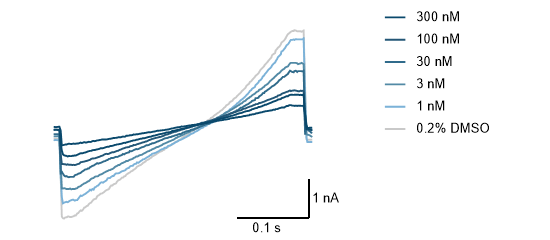Ion Channel Studies
TRP Channels
Flexible assay formats
Sygnature Discovery’s flexible assay formats offer an extensive range of optimized TRP channel assays, providing accurate, reliable data without the challenges of in-house development. Leveraging this adaptability, our scientists support rapid hit identification and investigation into TRP channel cross-reactivity, enabling efficient exploration and identification of novel, target-selective compounds. This flexible approach empowers drug discovery efforts with tailored solutions designed to meet unique research needs and accelerate project timelines.
Contact Syganture Discovery
To learn more about our services or to request a quote.
TRPA1 Electrophysiology

Figure 1: Representative TRPA1 current traces before (grey line) and during the presence of increasing concentrations of the blocker A967079 (blue lines). A 300 ms ramp protocol from -60 mV to +60 mV, from a holding potential of +0 mV and repeated every 30 seconds is used to monitor the TRPA1 current.

TRP Channel Case Studies
Here is a list of our TRP Channel Case Studies click on a title to view the full case study.




